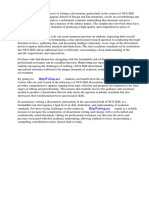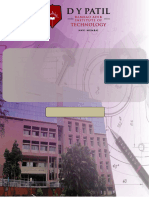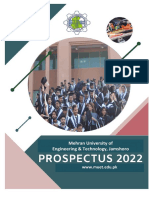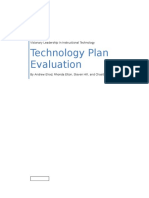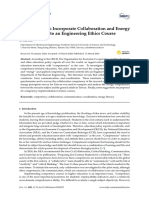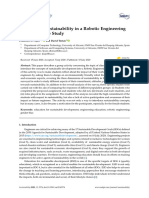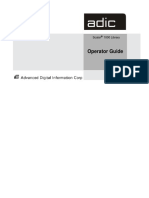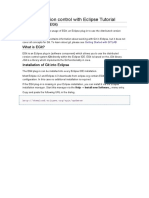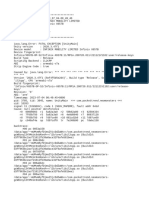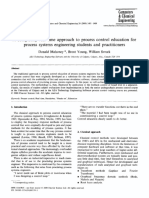EPICS: Engineering Projects in Community Service
EPICS: Engineering Projects in Community Service
Uploaded by
Arpan MajumdarCopyright:
Available Formats
EPICS: Engineering Projects in Community Service
EPICS: Engineering Projects in Community Service
Uploaded by
Arpan MajumdarOriginal Title
Copyright
Available Formats
Share this document
Did you find this document useful?
Is this content inappropriate?
Copyright:
Available Formats
EPICS: Engineering Projects in Community Service
EPICS: Engineering Projects in Community Service
Uploaded by
Arpan MajumdarCopyright:
Available Formats
IJEE 1549
Int. J. Engng Ed. Vol. 21, No. 1, pp. 000000, 2005
Printed in Great Britain.
0949-149X/91 $3.00+0.00
# 2005 TEMPUS Publications.
EPICS: Engineering Projects in Community
Service*
EDWARD J. COYLE, LEAH H. JAMIESON and WILLIAM C. OAKES
College of Engineering, Purdue University, West Lafayette, IN 47907, USA. E-mail: coyle@purdue.edu
Engineering Projects in Community Service, EPICS, is an engineering design program that
operates in a service-learning context. EPICS students earn academic credit for their participation
in design teams that solve technology-based problems for not-for-profit organizations in the local
community. The teams are: multidisciplinarydrawing students from across engineering and
around the university; vertically-integratedmaintaining a mix of freshman through seniors each
semester; and long-termeach student participates in a project for up to seven semesters. The
continuity, technical depth, and disciplinary breadth of these teams enable delivery of projects of
significant benefit to the community.
THE EDUCATIONAL NEED
addressing the desired issues as they perform
their tasks.
UNDERGRADUATE STUDENTS in engineering face a future in which they will need more than
just a solid technical background to be successful.
In setting the goals for any system they are asked
to design, they will be expected to interact effectively with people of widely varying social and
educational backgrounds. They will then be
expected to work with people from many different
disciplines to achieve these goals. They thus need
educational experiences that help them develop
these skills.
Among the most dramatic statements about the
importance of these skills are the set of desired
educational outcomes that form the heart of the
engineering accreditation guidelines, dubbed
`Engineering Criteria 2000', that went into effect
in the United States in 2000 [1]. In addition to
knowledge of engineering, mathematics, and
science, and experience in engineering problem
solving and system design, these criteria call for
students to be able to function on multidisciplinary
teams and to communicate effectively. They also
call for students to understand a wide range of
issues, including the importance of professional
and ethical responsibility and the societal and
global impacts of engineering solutions.
One effective response to these calls for reform is
a curriculum that engages students in `real-world'
experiences [28]. The design of these experiences
is crucial; they must offer students a compelling
context for engineering design, a multi-disciplinary
team experience, sufficient time to learn and practice professional skills, personalized mentoring,
and exciting technical challenges. The combination
of these five characteristics ensures that students
will immerse themselves in the engineering
experience, thus learning the desired skills and
THE COMMUNITY NEED
While educators seek to provide learning environments that prepare students for life as engineering professionals, not-for-profit organizations
such as community service agencies, schools,
museums, and local government officesface a
future in which they must rely to a great extent
upon technology for the delivery, coordination,
accounting and improvement of the services they
provide to the community. They often possess
neither the expertise nor the budget to acquire or
design a technological solution that is suited to
their mission. They thus need the help of people
with strong technical backgrounds.
The responses to this need for technology in the
not-for-profit sector have taken many forms. At the
federal level in the USA, the National Institute on
Disability and Rehabilitation Research (NIDRR)
provides leadership and support for a comprehensive program of research related to the rehabilitation of individuals with disabilities. NIDRR
sponsors ABLEDATA, a federally funded project
whose primary mission is to provide information on
assistive technology and rehabilitation equipment
available from domestic and international sources
to consumers, organizations, professionals, and
caregivers within the United States.
At the state level in the USA, there are many
forums for the exchange of ideas and processes for
improving social services with technology. For
example, the 2003 Conference on Information
Technology Strategies for Social Services offers
many insights into ways that social services can
utilize technology to improve their effectiveness
and efficiency. The Journal of Technology in
Human Services explores the uses and potentials
* Accepted 14 July 2004.
E. Coyle et al.
of computer and related technologies in mental
health, developmental disabilities, welfare, and
other human services.
The existence of these information resources
does not, by itself, guarantee that they will benefit
every agency or individual that needs them. Again,
there is a need for people with strong technical
backgrounds that can work closely with not-forprofit organizations to advise them on the use of
technology. Such people are absolutely essential
when special needs call for new technology to be
developed or for existing technology to be
modified.
EPICS: COMBINING ENGINEERING
EDUCATION AND SERVICE TO THE
COMMUNITY
The Engineering Projects in Community Service
(EPICS) Program was initiated at Purdue in 1995
to fulfill the complementary needs of engineering
undergraduates and the community [9]. Under this
program, undergraduates earn academic credit for
their contributions to long-term, team-based
design projects that deliver innovative, technology-based solutions to problems identified by
not-for-profit organizations in the community.
The unique structure and operation of EPICS
enables solutions of significant benefit to the
community to be delivered. Key features of the
EPICS model include the following attributes.
While one or sometimes several of these attributes
of EPICS can be found in other design programs,
EPICS is unique in combining all of them.
Community partners
Each EPICS team is matched with a not-forprofit organization in the community that is
referred to as the `project partner.' The team and
its project partner work closely together to identify
and solve the project partner's technology-based
problems. The end result is the delivery and
support of a system that is used by the project
partner to improve the services they provide to the
community. The partner's suggestion of project
ideas and constant feedback on the efficacy of
the systems being developed and deployed
provides the `real-world' context for each EPICS
project. An EPICS team's deliveryin most cases,
at no costof systems that the project partner
requests, provides the `real-world' assistance that
the partner needs to better serve the community.
The very beneficial effects that these systems have
on the community provide a compelling reason for
students to join and pursue these projects.
Large, vertically-integrated teams
Each EPICS team consists of eight to twenty
students, thus enabling projects of significant scale
and potential impact on the community to be
undertaken. The large team size also enables
them to be vertically-integrated; that is, to include
freshmen, sophomores, juniors and seniors. In
general, the seniors provide technical and organizational leadership, the sophomores and juniors
perform the technical work organized by the
seniors, and the freshman learn about the project
partner's needs and participate in teams tasks as
possible.
Long-term student participation
An EPICS student can participate in an EPICS
team for up to seven semesters, joining a team in
the second semester of the freshman year, remaining with the team until graduation. New freshmen
or sophomores replace students that graduate or
otherwise leave the team. There is thus significant
continuity in team membership from semester to
semester and year to year. When this continuity in
membership is combined with team procedures for
the training of new students and with mentoring by
senior members and team advisors, the team's
effectiveness can be maintained for as long as
required to complete a large-scale project. This
continuity also provides each student with the
time and mentoring opportunities required to
learn and practice different roles on the team,
from trainee to design engineer to team leader.
Variable credit hours
An EPICS student earns one credit per semester
as a freshman or sophomore. As juniors or seniors,
they earn 1 or 2 credits per semester, with the
choice being made by the student each semester.
The doubling of credits available to juniors and
seniors parallels their growing technical capabilities and organizational responsibilities. How the
academic credit counts towards a student's
graduation requirements varies by department.
For example, in ECE, up to 6 credits may be
used as ECE elective credit, and 3 credits in the
senior year may be used to fulfill the capstone
design requirement. ME students may use up to 6
credits to fulfill a technical elective requirement.
Multidisciplinary teams
The large team size also enables students from
disciplines across engineering and around the
university to participate in an EPICS team. The
disciplinary composition of an EPICS team can
thus be tuned to a project's needs. For example,
teams producing devices to assist children or adults
with disabilities have drawn from such disciplines
as electrical engineering, mechanical engineering,
computer science, child development and nursing.
Start-to-finish design experience
EPICS provides a start-to-finish design experience for students. Each project begins with identification of the project partner's needs and the
definition of a project to meet one of more of
those needs. It then progresses through design,
development, testing and deployment with the
project partner. This process typically takes two
or more years, thus providing the students with
EPICS: Engineering Projects in Community Service
sufficient time to master the many different aspects
of an engineering design project, including: exploration of design alternatives, project planning and
management, team leadership, technical innovation, design revisions, and economic considerations.
EPICS AND SERVICE LEARNING
Service learning combines service to the community with student learning in a way that benefits
both the student and the community. According to
the US National and Community Service Trust
Act of 1993 (as amended through December 17,
1999, P.L. 106170):
Title INational and Community Service State
Grants Program
Subtitle AGeneral Provisions
Section 101 [42 U.S. C. 12511] Definitions:
(23) SERVICE LEARNING:
The term `service-learning' means a method:
(A) under which students or participants learn
and develop through active participation in
thoughtfully organized service that (i) is
conducted in and meets the needs of a community;
(ii) is coordinated with an elementary school,
secondary school, institution of higher education,
or community service program, and with the
community; and (iii) helps foster civic responsibility; and
(B) that (i) is integrated into and enhances the
academic curriculum of the students, or the educational components of the community service
program in which the participants are enrolled;
and (ii) provides structured time for the students
or participants to reflect on the service experience.
A summary of the legislative history of national
and community service in the United States can
be found at http://www.nationalservice.org/about/
lhistory.html
The benefits of integrating service learning into
an engineering curriculum have been documented
in several recent papers, including [10]. Recent
examples of engineering service learning programs
include projects integrated into freshman-level
introductory courses [11, 12], capstone senior
design courses [12, 13], and multidisciplinary
approaches [14]. Other initiatives have sought to
integrate the co-curricular activities of student
organizations with engineering service learning
[15].
The EPICS program embeds engineering design
in a service-learning context [16]. This interweaving of design- and service-learning into an ambitious multidisciplinary, vertically-integrated course
structure with an emphasis on long-term community partnerships and long-term engineering
projects is unique to the EPICS program.
The service context for each EPICS design
project provides a very compelling framework for
the students. Metacognitive activities are woven
into each semester to allow students to understand
the connections between their technical projects
and the community issues they are helping to
address [17]. EPICS students thus learn many
valuable lessons in citizenship, including the role
of community service in our society; the significant
impact that their engineering skills can have on
their community; and that assisting others leads to
their own substantial growth as individuals, as
engineers, and as citizens.
EPICS: A CONCISE HISTORY AND
OPERATIONAL DETAILS
EPICS was initiated in the School of Electrical
and Computer Engineering at Purdue University
in Fall 1995, with 40 students participating on five
project teams. The program has grown steadily in
both size and breadth. In the 200203 academic
year, over 400 students participated on 24 teams,
addressing problems ranging from data management for social services to mitigation of agricultural pollution and from designing learning centers
for local museums to developing custom play
environments for children with disabilities.
EPICS spans all engineering disciplines at Purdue
and includes students from over 20 university
departments.
Each EPICS project involves a team of eight to
twenty undergraduates, a not-for-profit community partnerfor example, a community service
agency, a museum or school, or a government
agency and a faculty or industry advisor. A pool
of graduate teaching assistants from seven departments provides technical guidance and administrative assistance.
Each EPICS team is vertically-integrated,
consisting of a mix of freshmen, sophomores,
juniors, and seniors and operates for several
years, from initial project definition through final
deployment. Once the initial project(s) is/are
completed and deployed, new projects are identified by the team and its project partner, thus
allowing the team to continue to work with the
same community partner for many years. Each
undergraduate student may earn academic credit
for several semesters, registering for the course for
1 or 2 credits each semester. The credit structure is
designed to encourage long-term participation,
and allows multi-year projects of significant
scope and impact to be undertaken by the teams.
Each student in the EPICS program attends a
weekly two-hour meeting of his/her team in the
EPICS laboratory. During this laboratory time,
the team members address administrative matters,
do project tracking and planning, and work on
the technical aspects of their project. All students
also attend a common one-hour lecture each
week. A majority of the lectures are by guest
experts, and have covered a wide range of topics
related to engineering design, communication,
and community service.
E. Coyle et al.
The long-term nature of the program has
required some innovation in the lecture series
because students may be involved in the program
for several semesters. This has been addressed by
rotating the lecture topics on a cycle of two to
three years and by creating specialized lecture
supplements called skill sessions that students can
substitute for lectures they have already seen.
Example skill session topics include learning to
operate a mill or lathe, developing effective
surveys, conducting patent searches, and tutorials
on multimedia software. Students use the skill
sessions as a way of gaining specific expertise
needed for their projects and as an opportunity
to broaden their experience, for example, a computer engineering student learning to use a lathe or a
mechanical engineering student learning web
programming.
PHASES OF EPICS PROJECTS
The curricular structure of EPICS enables longterm projects. Over time, each project has five
phases: establishing project partners, assembling
a project team, developing a project proposal,
system design and development, and system
deployment and support.
Phase 1: Establishing project partnerships
The university-community partnership is at the
heart of any service-learning program. In the
context of EPICS, this entails exploring the technology needs and aspirations of local not-forprofit organizations.
When planning for the EPICS program started
in 1994, we were able to contact many different
service agencies by making a presentation about
the envisioned program and its goals to the directors of all local United Way agencies. Information
about United Way of Greater Lafayette, the
organization that hosted the meeting at which the
concept of EPICS was presented to the director's
of many agencies, can be found at: http://
www.uw.lafayette.in.us/. In other countries, a
different approach to identifying and contacting
potential project partners may be needed.
This single presentation led to many discussions
with individual agencies and a long list of potential
projects. The selection of community partners,
designated Project Partners, from this first set of
agencies was based on four key criteria:
1. Significancenot all projects can be undertaken, so partners whose projects should provide the greatest benefit to the community are
selected.
2. Level of technologyprojects must be challenging to, but within the capabilities of, undergraduates in engineering.
3. Expected durationprojects that will span
several semesters offer the greatest opportunity
to provide extensive design experience on the
academic side and to address problems of
potentially high impact on the community
side. It has also proven valuable to achieve a
mix of short- (one semester to one year) and
long-term (multi-year) projects, in that the
short-term projects build confidence and help
establish the relationship between the student
team and the community partner.
4. Project partner commitmenta crucial element
of the program has been the commitment of
individuals in the partner organizations to work
with the students to identify projects, specify
requirements, and provide ongoing critical
feedback.
Each year, EPICS has added new teams using the
significance, level of technology, expected duration, and project partner commitment criteria.
Since the first round of projects that grew out of
the United Way presentation, the source of new
projects has been varied. Faculty have initiated
some projects; students have suggested others. As
the program has become known in the community,
several projects have been proposed by local
community organizations. From five initial teams
in Fall 1995, the program has grown to 24 teams,
as summarized in Table 1.
Phase 2: Assembling a project team
Once a project and project partner have been
identified, a student team is organized. This is done
through discussions with and mailings to academic
counselors, by advertising the projects each semester in an evening callout and in undergraduate
classes, and via on-line registration at Purdue's
EPICS
website:
http://epics.ecn.purdue.edu/.
Eight to twenty students are chosen for each
project team, with the assignment of students
managed by the EPICS Student Advisory Council,
on which each team has a representative.
Depending on the project's needs, a team may
select students from multiple engineering disciplines and many non-engineering disciplines.
Over 20 academic majors have been involved in
the program, including electrical, computer,
mechanical, civil, aeronautical, biomedical, and
industrial engineering, computer science, sociology, psychology, education, audiology, English,
nursing, visual design, forestry and natural
resources, chemistry and management.
Vertical integrationa mix of freshmen, sophomores, juniors, and seniorsis also a factor in
team assignments. Teams need both technically
advanced members (typically juniors and seniors)
to spearhead technical progress and (academically)
younger members who are learning about the
project and will carry it into future semesters.
The combination of a vertically-integrated team
and long-term student participation ensures continuity in projects from semester to semester and
year to year. Projects can thus last many years as
new students are recruited for the project to
replace graduating seniors.
EPICS: Engineering Projects in Community Service
Table 1. The 24 EPICS teams active at Purdue during the 200304 academic year
Community partner
Year
initiated
Wabash Center Children's
Services
1995; 2nd
team
added in
1996
M.D. Steer SpeechLanguage and Audiology
Center
Lafayette Crisis Center
1995
1995
Greater Lafayette Affiliate
of Habitat for Humanity
1996
Happy Hollow Elementary
School
1997
Klondike Elementary
School
1997
Imagination Station (local,
interactive science and
space museum)
1997, 2nd
team
added in
1999
1997
Purdue's Office of the
Dean of Students Adaptive
Programs
Tippecanoe County
Historical Association
1997
Lafayette Adult Resource
Academy
1998
Wabash Center Greenbush
Industries
Purdue Department of
Forestry and Natural
Resources
1998
1998
Tasks
Develop computer-controlled toys for children with physical disabilities.
Develop an artificial sensory environment to provide multi-sensory
stimulation and a sense of control to children with physical disabilities.
Provide ways for physically disabled children to control their motion and to
play with peers.
Automate calculation of speech rate for clinical sessions. Design specialized
speech recognition systems. Design directional microphone system for hearing
aids.
Design stand-alone kiosks that will provide information about community
services to people in need of assistance. Incorporate means of contacting
appropriate agencies.
Design systems, structures, and floor plans to minimize home construction
and energy costs. Investigate new construction techniques and materials.
Design data management systems for local, regional and national operations.
Develop technology-based interfaces to improve the usability of school
science, computing, and media facilities, including a weather station and a TV
studio. Develop an interactive science center in the school.
Design custom educational software, multimedia and interactive tools for use
in the school. Develop technology-based solutions to school infrastructure
problems.
Develop hands-on exhibits that demonstrate science and engineering
principles for the Imagination Station Interactive Science and Space Museum.
Design classroom furniture for physically handicapped college students;
develop closed-captioning systems for deaf and hard-of-hearing college
students.
Develop multimedia and electromechanical systems for on-line storage and
interactive presentation of historical information.
Develop computer hardware and software to help non-native English
speaking adults become acquainted with the community and gain job-related
English skills; develop a uniform computer interface to allow LARA staff to
use a wide range of computer programs with their clients; develop software to
facilitate record-keeping and reporting.
Develop aids to assist workers with disabilities as they perform simple
manufacturing tasks.
Develop and construct a test constructed-wetlands area to mitigate
agricultural runoff from cattle, dairy, and swine farms and to treat creek
water. Develop educational infrastructure to make the constructed wetlands
an environmental education center for the community.
Lafayette Columbian Park
Zoo
1999
Design a multimedia learning center, including exhibits, kiosks, interactive
computer programs, and sound systems for the zoo.
The Anita Borg Institute
for Women and
Technology
Tippecanoe County
Probation Department
EPICS Administration
1999
Develop information technologies, and tools based on the perspective, and
needs of women, with focus on home, family and community.
2000
Develop a database system to assist the Tippecanoe County Probation
Department in pre-sentence investigations and supervision of clients.
Design multi-function, distributed information systems to help EPICS teams
and the EPICS administration document and manage program and project
activities and share information, experience, and expertise.
Develop effective models for using new computation and communication
technologies in pre-college classrooms and collaborative learning
environments. Design networks of specialized tools to facilitate group
learning and problem solving focused on `real life' situations or simulations.
Work with local community organizations and industries to improve the
Elliot Ditch eco-system which runs adjacent to local industries and through
residential neighborhoods.
Develop information distribution systems to enable the Purdue Cooperative
Extension Services to serve its constituents more effectively.
2000
Purdue School of
Education's Dean's Office
2000
Indiana Association of Soil
and Water Conservation
Districts
Tippecanoe County Purdue
Cooperative Extension
Service
Art Museum of Greater
Lafayette
2001
2001
2002
Lafayette School
Corporation
2002
Greater Lafayette
Volunteer Bureau
LEGO Scanning Probe
Microscope
2003
West Lafayette Public
Library
2003
2003
Disciplines
CmpE, EE, MatE, ME,
CS, Nursing, Child
Development
EE, CmpE, CS, Audiology
and Speech
EE, ME, CmpE, IE, CS,
Liberal Arts
Civil-E, EE, ME, CmpE,
IE, Mgmt, CS
EE, ME, CmpE, CS,
Education
CmpE, EE, ME,
Education, Liberal Arts
EE, IE, ME, CmpE, CS,
CE, ChmE, Liberal Arts,
Education
EE, ME, CS, CmpE,
Liberal Arts
EE, CmpE, ME, CS,
Education, Liberal Arts,
History
EE, ME, CmpE, CS,
Liberal Arts, Education
EE, ME, IE, CmpE
CE, EE, ME,
Environmental Engr,
Chem, Bio, Natural
Resources, Agriculture,
Forestry
CmpE, CS, EE, Civil-E,
ME, Visual Design,
Education
EE, CmpE, CS, Comm,
ChemE, Liberal Arts
CS, CmpE, Sociology
CS, CmpE, Mgmt
CS, CmpE, EE, ME,
Liberal Arts
CE, EnvirE, AgBioE,
English, Natural Resources,
Forestry
CmpE, CS, EE, ME,
Agriculture, Liberal Arts
Art and Design, Building
Construction Management,
Computer Graphics
Technology, EE, IE, ME,
Art Education, Art History
ME, CS, CmpE, Math,
Develop outdoor science laboratory for high school with particular attention
to issues in biology and environmental engineering. Develop and manufacture Edu, EE, Eng Edu, Earth
& Atmospheric Sciences
equipment to assist children with physical disabilities.
Develop software applications that assist the bureau in its mission of
CmpE, CS, IDE, Liberal
matching volunteers with social service agencies.
Arts
Utilizing LEGOs and Mindstorm products, develop a larger than life, LEGO- CmpE, EE, ME, Computer
based scanning probe microscope to illustrate the basic principles behind this Graphics Technology,
Physics, Visual Design
instrument that has proved to be a pivotal tool in the emergence of
nanotechnology. Develop a design appropriate for a permanent museum
display and a portable design for K-12 classroom demonstration.
CS, ECE, EE, Computer
Develop software support for the library's new facility, including and
Graphics Technology,
extensible and dynamically generated web presence, reliable and secure
Technical Writing
wireless and wired networks, printing systems, and a multi-platform music
repository.
Design and develop an environmental monitoring system for the museum to
better preserve their collections. Design and develop interactive activities for
patrons of the museum. Create an attractive environment for the museum
while implementing outreach and educational programs.
E. Coyle et al.
Phase 3: The project proposal
During the first semester of a project, the project
team meets several times with its project partner
and the team's EPICS advisor to define the project
and determine its goals. During this phase, the
project team learns about the mission, needs, and
priorities of the project partner. A key aspect of
this phase is identifying projects that satisfy three
criteria: they are needed by the project partner,
they require engineering design, and they are a
reasonable match to the team's capabilities. This
process of project definition culminates in a written proposal and presentation. The proposal must
be approved by the EPICS advisor and accepted
by the project partner.
Phase 4: System design and development
Following acceptance of the proposal, the
project team's goal is to produce a prototype of
the proposed system or service. Regular interaction with the project partner continues in order
to ensure that the products being designed and
developed are as desired. The formal portion of
this interaction includes written progress reports,
periodic design reviews, and presentations. A
faculty advisor and graduate TA meet weekly
with the team to provide technical supervision.
This phase of a project lasts as many semesters
as necessary for the team to complete the project to
the satisfaction of the project partner.
Phase 5: System deployment and support
The ultimate goal of each project team is to
deliver a product or service to their project partner.
The team must train representatives of the partner,
collect feedback, and make any reasonable changes
requested by the partner. One of the hallmarks of
the EPICS program is that the systems designed
and built by the students are deployed in the field,
where they provide real, needed benefits to the
community. It has been our experience that after a
team fields a project, the team and project partner
work together to develop new project ideas in
order to continue the relationship. The students
on the team in future semesters assume responsibility for supporting and maintaining the fielded
projects. This structure not only provides the local
community with useful projects, but also provides
long-term technical support resources for the local
agencies and organizations.
EVALUATIONS OF THE EPICS PROGRAM
Student evaluations
Student evaluations of the program have
included quantitative evaluation along the specific
educational objectives, as well as descriptive
formative and summative evaluations. A majority
of the students polled have cited the opportunity to
obtain `practical, real-world experience in engineering design' as their primary reason for participating in the EPICS program. A significant
number have also identified the opportunity to
do community service as a major factor in their
participation. Many of the students report that
they have done community service in the past, in
activities such as tutoring, church work, scouting,
soup kitchens, crisis hotlines and volunteer work
for Habitat for Humanity. They have not,
however, reported prior experiences that combine
community service with engineering.
Since the start of EPICS, we have tracked the
retention of students in the program: the rate at
which students who are able to return to EPICS
(i.e., have not graduated or are not off campus on
a cooperative industry assignment) do so. The
overall retention rate from one semester to the
next has been over 77%.
Quantitative evaluation has focused on specific
course/program objectives. Table 2 shows the
percentage of students rating the course with an
A or B grade for each objective, accumulated over
15 semesters starting in Spring 1996. Ability to
work on a team consistently receives the highest
grades, followed by Communication skills and
awareness of the customer in an engineering project.
As part of the summative evaluations, students
were asked: `What impact, if any, has the EPICS
program had on your resolve to continue in engineering?' Over the seven semesters that this data was
collected, 70% of the students responded that their
participation in the EPICS program positively
impacted their resolve to continue in engineering.
Among the 30% who did not respond positively,
several indicated that they were already committed
to engineering before and remained so after their
EPICS experience, such as graduating seniors.
Qualitative data collected as part of the summative evaluation included students' responses to the
question, `What are the three most valuable things
you have learned as a participant of the EPICS
program?' As can be seen in Table 3, `teamwork' is
the most common response to this question; it is
selected by an average of 86% of the students each
semester. The students also frequently report
learning other professional skills that are part of
the ABET criteria, including `communication
skills' and `project planning'. This is noteworthy
because it is difficult to teach these skills in
traditional classes. `Leadership' is also selected
frequentlyapproximately one third of the
EPICS students eventually assume leadership
roles on their teams.
It is interesting to compare these scores with
those who listed and did not list technical skills. It
has been our experience that the students underreport improvements in their technical skills
because of the experiential learning environment.
In focus groups, students who did not identify
improvement in technical skills could articulate
significant development in technical areas. They
did not, however, attribute these to the EPICS
experience because they felt that they had learned
the new material themselves or `on their own'
rather than being `taught' the material. Because
EPICS: Engineering Projects in Community Service
Table 2. Percent of students responding with a grade of A or B to the question: `Evaluate the
impact that EPICS has had for you on your. . .' A total of 2835 responses were accumulated
over 15 semesters: Spring 1996 through Spring 2003.
Average for Spring 1996
Spring 2003
Attribute
Technical skills
Understanding of the design process
Communication skills
Ability to work on a team
Resourcefulness
Organizational skills
Awareness of the community
Awareness of the customer in an engineering project
Awareness of ethical issues
OVERALL EVALUATION
no one lectured or tested them on a technical topic
that they learned on their own or as a group, they
did not attribute the learning experience to the
EPICS program.
Summative written responses of the students'
experience include free response questions. Representative comments include:
. EPICS completely changed my opinion of engineering.
. Working on this project has helped me guide the
rest of my course work and ideas for a future
profession.
. Other engineering courses only directly benefit
me. EPICS benefits everyone involved.
. I have learned that engineering includes more than
theory, it includes teamwork, communication,
organization and leadership.
. It made me understand how every aspect of engineering (design, implementation, team work,
documentation) come together.
. No longer is engineering just a bunch of equations,
now I see it as a means to help mankind.
. Opened my heart.
No formal evaluation has yet focused on the
experiences of the women students in EPICS.
However, with its focus on engineering in context
and strong emphasis on teamwork, communication and commitment, it appears that EPICS
is serving as an effective vehicle for encouraging
women in engineering and computer science. Over
71%
80%
83%
88%
79%
77%
73%
81%
68%
84%
a five-year window, enrollment of women in ECE
and ME at Purdue ranged from 10% to 12%, while
20% of ECE and ME students in EPICS were
women. In Spring 2001, 33% of the CS students
in EPICS were women, compared to 11.5% of the
undergraduates in CS. In the first 3 years of the
program, during which 20% of the students in
EPICS were women, approximately 30% of the
team leaders were women.
We hypothesize that broadening the notion of
an engineer's core competencies to include the
broad spectrum of skills associated with authentic
design may contribute to achieving a population of
engineering professionals that is gender- and ethnically-diverse [18, 19]. Approaches that have been
cited in the literature as positive steps toward
encouraging women to stay in science and engineering include framing science in its social context;
stressing general educational goals, including communication, in engineering education; employing
cooperative, interdisciplinary approaches; and
undertaking problems with a holistic, global
scope [2022]. Matyas and Malcolm [23] and
Oakes, Gamoran and Page [24] suggest that
many of the same factors are relevant for attracting and retaining minorities.
Alumni evaluations
Formal evaluations of the alumni perspective
have not yet been done; however, there is
significant evidence that alumni highly value their
Table 3. Student responses to the question: What are the three most valuable things you have learned from being a part of the
EPICS program?
Categories of responses (with representative variations of comments)
Teamwork (teamwork, working with others, cooperation, accountability)
Leadership (leadership, responsibility, motivating self and others, taking initiative)
Communication (communication skills, presentation skills, public speaking, report writing, communicating
with clients)
Organization and Planning (organization, project planning, time management, meeting deadlines and
timelines, goal setting)
Technical Skills (technical expertise, programming, design process, testing, technical procedures)
Real World Experience (real applications, realistic view of working world, experience for real life)
Customer Awareness (customer needs, customer support)
Community Awareness (community needs, contribution to the community, value of service)
Total Number of Respondents
Total number of
student responses
1751
534
1008
793
754
222
174
155
2044
E. Coyle et al.
experiences in EPICS. The most concrete examples
are the following efforts to support or expand
EPICS that have been initiated by EPICS alumni:
Four EPICS teams currently have corporate
sponsorships that were initiated within those
corporations by EPICS alumni.
Creation of the first High School EPICS
program by EPICS alumni from the Crane Division of the Naval Surface Warfare Center and
Visteon. These alumni initiated and have been
advising an EPICS team at Bedford-North
Lawrence High School in Bedford, IN since 2003.
Creation of a scholarship for Civil Engineering
students involved in EPICS. This effort was
initiated and funded by EPICS alumni.
An EPICS alumnus who won the ECE Alumni
Design Award cited EPICS as the course having
the most influence on his development as a design
engineer.
Community partner evaluations
Community partners provide a valuable means
of assessing the success of the EPICS program. A
key measure of community satisfaction has been
the retention of project partners. In the eight years
since the start of EPICS, teams have worked with a
total of 28 different project partners (some partners, such as the Homelessness Prevention
Network, include several organizations). Twentyfour of these partnerships are still in place. Over
half of the teams have completed their original
projects; in all but one instance, the community
partner has presented the team with new project
ideas in order to continue the relationship. Four
partnerships have been terminated. One agency to
which three software projects had been delivered
reported that its needs had been met. One agency
was able to identify funds to purchase a commercial product similar to the one being developed by
the team, and deemed this a quicker path to
having a system in place. A third partnership
terminated when the agency filed for bankruptcy
protection and a fourth project terminated when
the project was turned over to the city Parks
Department.
The high level of satisfaction of the project
partners is also reflected in surveys of the project
partners. In the 200001 academic year, 100% of
the project partners indicated they were satisfied or
very satisfied with their experience with the EPICS
program. In 200102, 95% reported being very
satisfied or satisfied and 5% had a neutral experience. EPICS has received four awards from the
community: the 2003 Indiana Governor's Award
for Outstanding Volunteerism, a certificate of
Outstanding Achievement from the Wabash
Center in 1998, and recognition in the 2000 and
2001 West Lafayette Community Honor Roll.
A final indicator of the success of the EPICS
program is the more than 150 projects delivered to
the local community. Table 4 provides a partial list
of these completed projects.
THE NATIONAL EPICS PROGRAM
The EPICS Program was created at Purdue
University in the Fall of 1995. Its new model for
large-scale engineering design projects in a
community context has since spread very quickly.
By 1997, EPICS programs were also underway at
the University of Notre Dame and Iowa State
University. The National EPICS Program was
created in 1999. The universities currently participating in this program are Purdue, Notre Dame,
Iowa State, the University of Wisconsin-Madison,
Georgia Tech, Case Western Reserve, Penn State,
Butler, the University of Illinois at Urbana-Champaign, the University of Puerto Rico-Mayaguez,
Columbia, the University of California at San
Diego, San Jose State University, Worcester Polytechnic Institute and the University of California
at Merced.
The existence of EPICS programs at several sites
opened the possibility of addressing community
and educational needs that extend beyond those of
a university and its local community.
The first multi-site EPICS project, the Homelessness Prevention Network project, was initiated
in 1997 when the newly formed HPN team at
Notre Dame began working not only with agencies
in its home city of South Bend, Indiana, but with
the Purdue HPN EPICS team as well. The local
goal for each team was to enable its partner
agencies to share demographic and servicesprovided information about their clients. The
agencies could then produce duplicate-free counts
of homeless individuals and families, meaningful
data on the use and effectiveness of services, and a
record for each client that can be used for casemanagement across all agencies and all available
services. The common goal of these two HPN
teams was the sharing of data on homelessness
between Lafayette and South Bend.
The second multi-site EPICS project was
initiated in 2002 with the Habitat for Humanity.
The Purdue, Wisconsin and Notre Dame EPICS
teams are working with the staff of Habitat for
Humanity International to produce a set of
construction tutorials for national distribution
and a database for affiliates to use for assessment
data of homeowners from across the country. The
national staff of Habitat for Humanity serve as the
project partner and offer the opportunity for
students at multiple sites to collaborate on
common projects. Each site also works with the
local affiliate of Habitat for Humanity to ensure
that the products being developed meet their needs
and will be used by such affiliates.
The National EPICS program provides the
infrastructure to support the growing number of
EPICS programs nationally and, eventually, internationally. Annual conferences have provided a
forum for faculty to come together and share the
results and best practices of their programs and to
learn from others. Web tools being developed to
support the directors and faculty involved in these
EPICS: Engineering Projects in Community Service
Table 4. Selected projects delivered to the local community by EPICS teams at Purdue
Project partner
Selected delivered projects
Wabash Center
Children's
Services
Dollhouse kitchen, bath, and bedroom with electronically controlled refrigerator door, lights, swimming duck,
lighted mirror, and sounds. Track-based dump truck with large-format, four-button wireless control. Custom
cap and RF controller to monitor posture and to control toys and software. Spaceship structure in which a child
in a wheelchair may play computer games at the control console. A four-button phone adapted for children with
disabilities. Modifications to commercially available electric car to allow safe use indoors and provide back
support for children with disabilities. Modified toy record player with easy-to-use handle. Custom multimedia
software for playgroup activities and interactive software for American Sign Language. Internet access, custom
web page, and tutorials on computer use for the clinic. Toy switch that is activated by an isolated finger to
develop fine motor skills. Internet access, custom web page, and tutorials on computer use.
Fourth grade curriculum modules on demonstrating Mechanical, Chemical, Materials and Electrical
Engineering. Eighth grade curriculum modules demonstrating Food Processing, Mechanical, Chemical,
Materials, and Civil Engineering. Digital Audio Systems display demonstrating CD and MP3 technology.
Portable digital-signal-processing-based voice transformation demonstrator.
Design of four-cell constructed wetland, selected and installed wetland plants into the wetland, pumping
system from feed stream, weir boxes for flow monitoring system, storage facility, instrumentation,
observation platform and educational material.
New design for house corners to minimize air leakage; thermal imaging of Habitat homes to determine
efficiency of Habitat construction techniques; pressure door to detect areas of heat loss. Standardization of
Habitat house designs, Web-based home selection guide, energy analyses for design variations, database to
manage inventory for Habitat resale store.
Web page software, electrical design for TV studio. Instrumentation that feeds weather station data to a web
page. Water garden display for a rainforest exhibit.Science museum exhibits: `Life-size camera': A flash wall
that uses strobe lights, a dark room, and phosphorous sheets to capture a student's shadow cast on a
phosphorescent wall. `Color wall' demonstrates principles of colored light. `Memory basketball:' Scorekeeping electronics added to an electronic basketball game to compare hits and misses for shots taken with
and without vision distorting goggles. Tornado: Project that simulates a miniature tornado in a Plexiglas box.
Theramin, laser harp.
Six client machines deployed with local agencies; server deployed and running. Version 5.0 of the software
included security and encryption features, full report generation capability, duplicate client-file merge
algorithm on server, and custom, private email system to enhance interagency communications. In 2001, the
county, in conjunction with the EPICS team, was awarded a Federal HUD grant to participate in a study of
homelessness, because the county was one of only 19 in the US that had a homelessness management
information system that met their qualifications. Prototype system also deployed for evaluation purposes to
Anderson, Indiana.
`History of the PC' exhibit with working hardware/software; bicycle-driven generator to demonstrate
principles of gears and power electromagnetism displaysmagnetic tower and Magnet Racer, interactive
science software installed in a dinosaur-shaped kiosk, interactive windtunnel, interactive mixer display to
illustrate density of fluids using oil and water mixtures.
Software games: Genie Lamp, M.A.S.H., Balloon-Blast, periodic table, math match numbers game, U.S. state
capitals, Great American Women. Educational website and an online environment for the girls. Technology
workshops for middle school girls. Prototype design of a `female friendly' collaborative software lab for
Purdue's CS Dept.
A database to track vital information for all adults that are on probation with the country's probation
department. The database has an MS Access front end and a SQL server backend. The database is in use at
25 different `client' computers, and will update/modify as changes are made. A prototype that that will track
both juvenile and adult offender. A web-based software prototype called `JDS2Go.'
An interactive English/Spanish guide to landmarks in the community. Prototype tutorial devices of a camera
and ruler that integrate the physical system with a computer of vocabulary building and training. A custom
desktop interface to simplify computer use for LARA staff. Driving simulator and tutorial, cash register
project to teach how to add and subtract money. Budget management travel game to teach budgeting skills.
Language and spelling tutorials to prepare learners for the Test for Basic Adult Education, including
database-driven pre- and post-tests.
Community information kiosks delivered to local homeless facility and public library. Kiosks provide
information about community service providers through a database touch screen monitor. Calls to the service
providers can be made using a modem and handset in the kiosks.
A large-scale working model of a key nanotechnology instrument that generates images of material at atomic
dimensions, built from LEGO1 for museum exhibits and K-12 outreach.
Remote classroom captioning using Microsoft NetMeeting, and a system of wireless microphones so a court
reporter can hear the lecture from their home and relay that information back to the student. Classroom
furniture: adjustable chair for students with chronic back problems; adjustable table for students in
wheelchairs. 75 chairs and 25 tables are placed in classrooms around campus as needed by Purdue students.
Infrared-controlled lock installed on a locker at a local school to allow a physically disabled student to
unlock her locker. Realistic tracheal model to help laryngectomy patients learn how to install in-dwelling
prosthesis. Voice-activated children's software to motivate speech in developmentally delayed children.
Software for computing speech rate of spontaneous speech. Prototype of glasses-mounted microphone array
system to improve directionality of hearing aids.
On-line history quiz and memory game. On-line arrowhead classification system. Prototype of searchable
image database. Prototype of a virtual tour of the main TCHA museum building. Kiosk for portable delivery
of team's software. 360 degree iPIX images for use on CD-ROM and TCHA website. Searchable, web-based,
database of watermarked digital images of the museum's collection and events.
Machined platform to aid workers with cerebral palsy in feeding a clamp onto plastic tube.
Electromechanical tube winding device. Rubber Grommet Fixture designed to make inserting rubber
grommets into the modeled plastic sheets feasible for workers with physical disabilities. Clamping device for
reassembly of corn sweetener filters. Shape-sorting board with electronic score-keeping and feedback, to help
workers with physical and mental disabilities to develop skills.
Purdue Dean of
Engineering and
Local K-12
Schools
Purdue Dept. of
Forestry &
Natural Res.
Habitat for
Humanity
Happy Hollow
Elementary
School
Homelessness
Prevention
Network
Imagination
Station
(Children's
Museum)
Institute for
Women and
Technology
Tippecanoe
County Probation
Department
Lafayette Adult
Resource
Academy
Lafayette Crisis
Center
LEGO Scanning
Probe Microscope
Purdue's Office of
the Dean of
Students
Speech-Language
and Audiology
Center
Tippecanoe
County Historical
Association
Wabash Center
Greenbush
Industries
10
E. Coyle et al.
programs will make the initiation and growth of
EPICS programs easier.
RESOURCES AVAILABLE TO THE EPICS
PROGRAM AT PURDUE
The most critical elements in the success of an
EPICS program are leadership of the program by
one or more faculty members and support by the
appropriate departmental and college administrators. This ensures that a high-quality design and
service learning experience will be provided to all
EPICS students in courses that are approved by
the faculty. Beyond these essential elements, the
level of student enrollment in EPICS depends upon
a combination of degree requirements in different
disciplines, available space, the number of potential faculty and industry-based advisors, and the
teaching credit that is offered for advising an
EPICS team. Note that the number of potential
project partners is typically not a limiting factor
contacts with the community, around the university, and with local government agencies yield as
many projects as desired.
Operational needs are in three broad areas: staff,
space/facilities and project expenses. Personnel to
support the EPICS program include team advisors,
teaching assistants, and administrative staff. The
level of advisor and TA support is matched to the
support provided for senior design courses. At
Purdue, faculty who advise an EPICS team for
one academic year (approximately 48 student
credit hours) receive teaching credit equivalent to
teaching a traditional 3-credit, one-semester course.
A half-time TA provides administrative support for
three to four teams and provides program-wide
technical support as a consultant in his/her area of
expertise. Administrative support varies with the
size of the program. Purdue's EPICS program, with
300 students on 24 teams each semester, is led by a
faculty director and co-director, with staff support
for program operations and facilities management.
Space requirements are for team meetings,
lectures and presentations, and project development. Class/meeting rooms that can be configured
for large-group discussions support the teams'
scheduled two-hour weekly meeting. The equipping of the meeting rooms with networked computers facilitates access to on-line resources and filing
of weekly reports. Computers and data projectors
support design reviews and presentations to
community partners. A large lecture hall is used
for the weekly, one-hour EPICS lecture and for the
teams' end-of-semester presentations. Lab needs
depend on the types of projects being undertaken
by the teams. At Purdue, flexible prototyping labs
with evening and weekend access have been effective in supporting a wide range of electrical,
electro-mechanical, and software projects.
The area in which EPICS resource needs differ
most greatly from traditional design courses is in
acquisition of equipment and parts for projects
that will be deployed in the community. For
typical projects, expenses for prototypes and
proof-of-concept systems are borne by the university. Once a system has been proven, the EPICS
team may work with the community partner to
raise funds (e.g., from a community foundation)
for larger-scale deployment. Based on over 300
team-semesters at Purdue, annual expenses average approximately $1500 per team per year. This is
supported primarily by corporate sponsors.
Additional resources and staff are available for
the National EPICS Program and the EPICS
Entrepreneurship Initiative, both of which support
the activities of all EPICS sites.
CONCLUSION
The Engineering Projects in Community Service
Program has added several new dimensions to the
educational experience of engineering undergraduates at Purdue University. These include vertically-integrated, large-scale, multidisciplinary
design teams; multi-year student participation that
enables them to experience all phases of the design
process; and large-scale design projects in a servicelearning context. Each EPICS team thus functions
as a small, but highly capable, engineering design
firm with a real customerits project partner from
the community. EPICS teams' ability to define,
develop, and deliver ambitious projects to their
partners in the community has fostered lasting
relationships with the community and a high level
of mutual commitment. This emphasis on multisemester, multi-disciplinary, customer-driven
design in the community context has made EPICS
a good match for the ABET EC 2000 criteria [25].
The program has demonstrated success through
student and community partner evaluations and
retention. Data from student evaluations demonstrate that EPICS is a model where professional
skills, including teamwork and communication,
can be learned while participating in realistic
design teams. The continued growth in terms of
numbers of students and numbers of projects is an
indicator of the success of the program and the
needs it is meeting. The adoption of the EPICS
model by 14 other institutions demonstrates that
the EPICS model transcends campuses.
AcknowledgmentsThe EPICS Program has been supported by
grants from the U.S. Department of Education's Fund for the
Improvement of Postsecondary Education (grant P116F50129),
the National Science Foundation's Instrumentation and
Laboratory Improvement Program (grants DUE96-50771 and
DUE98-51200), the Corporation for National Service Learn
and Serve America Higher Education Program (grants
97LHEIN025 and 00LHEIN025 00), the National Science
Foundation Action Agenda for Engineering Curriculum Innovation Program (grant EEC-0002638), the National Science
Foundation CCLI National Dissemination Program (DUE0231361) and by grants and donations from numerous companies and foundations, including Microsoft Research, HewlettPackard, the 3M Foundation, National Instruments, AMD, Eli
Lilly, General Motors, Boeing, the ADC Foundation, Rea
Magnet Wire Co., MDBS, Great Lakes Chemical, Abbott
Labs, PPG, Guidant, TRW, and Alcoa.
EPICS: Engineering Projects in Community Service
REFERENCES
1. ABET, Criteria for Accrediting Engineering Programs, The Engineering Accreditation Commission
of The Accreditation Board for Engineering and Technology (1999). http://www.abet.org/eac/
eac.htm.
2. M. Dahir, Educating engineers for the real world, Technology Review, Aug/Sept 1993, pp. 1416.
3. C. R. Peterson, Why integrate design? ASEE Prism, May 1993, pp. 2633.
4. ASEE, Engineering Education for a Changing World, Engineering Deans Council and American
Society for Engineering Education (1994). http://www.asee.org.
5. ASEE, Educating tomorrow's engineers, ASEE Prism, May/June 1995, pp. 1115.
6. M. Valenti, Teaching tomorrow's engineers, Mechanical Engineering Magazine, 118(7), July 1996,
pp. 6469.
7. T. W. Hissey, Education and careers 2000, Proc. IEEE, 88(8), August. 2000, pp. 13671370.
8. E. Fromm, The Changing Engineering Educational Paradigm, J. Eng. Educ., 92(2), April 2003,
pp. 113122.
9. E. J. Coyle, L. H. Jamieson and H. Dietz, Long-term community service project in the engineering
curriculum, Proc. 1996 ASEE Annual Conference: Capitol Gains in Engineering Education,
Washington DC, June 1996.
10. J. Duffy, E. Tsang, and S. Lord, Service-learning in engineering: What, Why, and How? Proc.
ASEE 2000 Conf., St. Louis, Missouri, June 2000.
11. R. S. Hobson, Service-learning as an educational tool in an introduction to engineering course,
Proc. ASEE 2000 Conf., St. Louis, Missouri, June 2000.
12. E. Tsang (ed.) Projects That Matter: Concepts and Models for Service-Learning in Engineering.
Washington, DC: AAHE (2000).
13. G. D. Catalano, P. Wray and S. Cornelio, Compassion Practicum: A capstone design experience at
the United States Military Academy, J. Eng. Educ., 90(4), Oct. 2000, pp. 471477.
14. A. Nagchaudhuri, A. Eydgahi and A.Shakur, SLOPE: an effort towards infusing service-learning
into physics and engineering education, Proc. ASEE 2000 Conf., St. Louis, Missouri, June 2000.
15. N. W. Stott, W. W. Schultz, D. Brei, D. M. Winton Hoffman and G. Markus, ProCEED: A
program for civic engagement in engineering design, Proc. ASEE 2000 Conf., St. Louis, Missouri,
June 2000.
16. E. J. Coyle, L. H. Jamieson and L. Sommers, EPICS: A model for integrating service learning into
the engineering curriculum, Michigan J. Community Service Learning, 4, Fall 1997.
17. L. A. Slivovsky, F. R. DeRego, Jr., Jamieson, L. H. and Oakes, W. C. Developing the reflection
component in the EPICS model of engineering service learning, Proc. 2003 Frontiers in Education
Conf., Boulder, CO, November 2003.
18. V. Tinto, Leaving College: Rethinking the Causes and Cures of Student Attrition, Chicago:
University of Chicago Press (1993).
19. E. Seymour and N. Hewitt, Talking About Leaving: Why Undergraduates Leave the Sciences,
Boulder, CO: Westview Press (1997).
20. N. Noddings, Gender and curriculum, Handbook of Research on Curriculum, P. W. Jackson (ed.),
New York: Macmillan (1992).
21. S. V. Rosser, Female-Friendly Science, Pergamon Press, Elmsford, NY (1990).
22. S. V. Rosser, Teaching the Majority: Breaking the Gender Barrier in Science, Mathematics, and
Engineering, Teachers College Press, New York, NY (1995).
23. M. L. Matyas and S. Malcolm, Investing in human potential: science and engineering at the
crossroads, AAAS, Washington, DC (1991).
24. J. Oakes, A. Gamoran and R. N. Page, Curriculum differentiation: opportunities, outcomes, and
meanings, Handbook of Research on Curriculum, P. W. Jackson (ed.), New York: Macmillan
(1992).
25. L. H., Jamieson, W. C. Oakes and E. J. Coyle, EPICS: documenting service learning to meet EC
2000, 31st ASEE/IEEE Frontiers in Education Conf., Reno, NV, October 2001.
Edward J. Coyle is a Professor of Electrical and Computer Engineering and Assistant Vice
Provost for Research at Purdue University. He is a co-founder of EPICS and the National
EPICS Program and currently serves as the Director of the EPICS Entrepreneurship
Initiative. He was a co-recipient of the American Society for Engineering Education's 1997
Chester F. Carlson Award for Innovation in Engineering Education for his work on the
EPICS Program. His research interests include computer and sensor networks and signal
and image processing. He is a Fellow of the IEEE.
Leah H. Jamieson is the Ransburg Professor of Electrical and Computer Engineering and
Associate Dean of Engineering for Undergraduate Education at Purdue University, where
she is co-founder and Director of the EPICS Program. She was a co-recipient of the
American Society for Engineering Education's 1997 Chester F. Carlson Award for
Innovation in Engineering Education, received the NSF Director's Award for Distinguished Teaching Scholars in 2001, and was named 2002 Indiana Professor of the Year by
the Carnegie Foundation and the Council for Advancement and Support of Education. Her
research interests are in the areas of speech recognition and parallel algorithms. She is a
Fellow of the IEEE.
11
12
E. Coyle et al.
William C. Oakes is an Associate Professor in the Department of Engineering Education at
Purdue University, where he is a Co-Director of the EPICS Program. He is an active
member of ASEE serving on the board of the Freshman Programs Division and on the FIE
Steering Committee. He was a recipient of 1993 ASME Graduate Teaching Fellowship, the
1997 Apprentice Faculty Grant from the ERM division of ASEE, and the 2004 NSPE
Engineering Education Excellence Award.
You might also like
- EDLD 5398 ETL Reflections I-VIII Kimberly McKayDocument11 pagesEDLD 5398 ETL Reflections I-VIII Kimberly McKaykjmckay915No ratings yet
- CMA-I 4063-01 TN 501 001 KW CBK KNPS Participant's Interfaces.2019!02!06Document29 pagesCMA-I 4063-01 TN 501 001 KW CBK KNPS Participant's Interfaces.2019!02!06RONYNo ratings yet
- (P78, P80, P90, R50, P58, R30, R50-M, R100) API Programming (V1.2.5)Document196 pages(P78, P80, P90, R50, P58, R30, R50-M, R100) API Programming (V1.2.5)1234567890No ratings yet
- MathType User ManualDocument125 pagesMathType User ManualGabriel EnNo ratings yet
- Integrating Engineering Education and Community Service: Themes For The Future of Engineering EducationDocument5 pagesIntegrating Engineering Education and Community Service: Themes For The Future of Engineering EducationSnehaIyerNo ratings yet
- Reading #3-EPICS Engineering Projects in CommunityDocument5 pagesReading #3-EPICS Engineering Projects in CommunityDani BaddourNo ratings yet
- Collaborativetechnologyplan Arnold Martin Ocampo KerrDocument28 pagesCollaborativetechnologyplan Arnold Martin Ocampo Kerrapi-280926971No ratings yet
- Experiential Learning Opportunities Exploring The Impact of Engineering Solutions-A Collaborative Gened-Engineering EffortDocument11 pagesExperiential Learning Opportunities Exploring The Impact of Engineering Solutions-A Collaborative Gened-Engineering EffortSoumya Suhreed DasNo ratings yet
- Engineering Service Learning With Green Information Technology and Systems ProjectsDocument6 pagesEngineering Service Learning With Green Information Technology and Systems Projectsxlar8No ratings yet
- Curriculum Design of UG Engineering ProgramsDocument31 pagesCurriculum Design of UG Engineering ProgramsUdaya Kumar SusarlaNo ratings yet
- 2018-19 Syllabus PES College of EngineeringDocument48 pages2018-19 Syllabus PES College of EngineeringKaushik SANo ratings yet
- Developing Technical Competency and Enhancing The Soft Skills of Undergraduate Mechanical Engineering Students Through Service LearningDocument6 pagesDeveloping Technical Competency and Enhancing The Soft Skills of Undergraduate Mechanical Engineering Students Through Service LearningAna Carolina Camargo ChristovamNo ratings yet
- New 2020 Project Type WritingDocument29 pagesNew 2020 Project Type WritingArsalan MughalNo ratings yet
- Review of Educational Technology Closing The Gap Between Modern Technology and The College Engineering ClassroomDocument10 pagesReview of Educational Technology Closing The Gap Between Modern Technology and The College Engineering ClassroomOdudu Ebu-nkamaodoNo ratings yet
- Ac 2009-740: Ewb 2 - Engineers Without Borders: Educationally, A World of BenefitsDocument23 pagesAc 2009-740: Ewb 2 - Engineers Without Borders: Educationally, A World of BenefitsEthanLaRochelleNo ratings yet
- District Technology Plan July 1, 2011 To June 30, 2015Document31 pagesDistrict Technology Plan July 1, 2011 To June 30, 2015api-134134588No ratings yet
- Fostering Innovation Through Experiential LearningDocument14 pagesFostering Innovation Through Experiential LearningAndrew TranNo ratings yet
- Research Assignment 6Document8 pagesResearch Assignment 6api-301569077No ratings yet
- Challenge Driven Education in The Context of Internet of ThingsDocument6 pagesChallenge Driven Education in The Context of Internet of Thingspantzos.stockholm.suNo ratings yet
- Educ 5324-sd Technology Plan TemplateDocument7 pagesEduc 5324-sd Technology Plan Templateapi-290737736No ratings yet
- Technology Plan FinalDocument10 pagesTechnology Plan FinalrustoryhufNo ratings yet
- 10 July Harangul India Workshop Report RVJDocument9 pages10 July Harangul India Workshop Report RVJapi-266430454No ratings yet
- Nus Dissertation SdeDocument9 pagesNus Dissertation SdeWebsitesToTypePapersSingapore100% (1)
- Digital Image Processing Notes: Rns Institute of TechnologyDocument248 pagesDigital Image Processing Notes: Rns Institute of TechnologyNeha GowdaNo ratings yet
- TechnologyplanevaluationDocument28 pagesTechnologyplanevaluationapi-310131918No ratings yet
- Bangalore Institute of Technology Department of Instrumentation TechnologyDocument3 pagesBangalore Institute of Technology Department of Instrumentation TechnologySyed MisbahNo ratings yet
- Service Learning in EngineeringDocument30 pagesService Learning in EngineeringkingmakemeNo ratings yet
- HMI New Format Labmanual 2023-24Document57 pagesHMI New Format Labmanual 2023-24bhagyashreepatil251997No ratings yet
- Learning ProposalDocument17 pagesLearning ProposalTaibur RahmanNo ratings yet
- Resta Think Piece... TecnologíaDocument3 pagesResta Think Piece... TecnologíaAntonia Bacab CaamalNo ratings yet
- Educ 5324 - SerdarDocument6 pagesEduc 5324 - Serdarapi-341055267No ratings yet
- Madonna University, Nigeria Department of Computer Science Undergraduate Academic ProgrammeDocument33 pagesMadonna University, Nigeria Department of Computer Science Undergraduate Academic Programmebatiya urbanusNo ratings yet
- 20-11-2022-Prospectus For 2022-23 Batch (18th Draft)Document216 pages20-11-2022-Prospectus For 2022-23 Batch (18th Draft)Musanif Ahmed FarooqiNo ratings yet
- Research Statement Generic 10 2014Document4 pagesResearch Statement Generic 10 2014api-267216248No ratings yet
- Chapter I-Corrected With GrammarlyDocument13 pagesChapter I-Corrected With GrammarlyJalil BenitoNo ratings yet
- PR2 G2 AutosavedDocument16 pagesPR2 G2 AutosavedOni GiriNo ratings yet
- Tech Plan ReviewDocument13 pagesTech Plan Reviewapi-233629301No ratings yet
- Wardlawb SharedvisionDocument5 pagesWardlawb Sharedvisionapi-270685921No ratings yet
- Course Outlines: Design Technology 2013-14Document6 pagesCourse Outlines: Design Technology 2013-14CIS AdminNo ratings yet
- Thesis About School FacilitiesDocument4 pagesThesis About School Facilitiesrokafjvcf100% (2)
- Technology Plan EvaluationDocument12 pagesTechnology Plan EvaluationSteven HillNo ratings yet
- pr2 1Document16 pagespr2 1maroine charity de royNo ratings yet
- Induction Program 2021-22Document15 pagesInduction Program 2021-22ROHIT SINGHNo ratings yet
- The Social Shaping of A Virtual Learning Environment: The Case of A University-Wide Course Management SystemDocument12 pagesThe Social Shaping of A Virtual Learning Environment: The Case of A University-Wide Course Management SystemAparna MuralidharanNo ratings yet
- Educ 5324-Technology PlanDocument6 pagesEduc 5324-Technology Planapi-290266366No ratings yet
- Hsu Collaboration and Energy Competency Into An Engineering Ethics Course Education-10-00072Document17 pagesHsu Collaboration and Energy Competency Into An Engineering Ethics Course Education-10-00072IonCotrutaNo ratings yet
- Maroine Research 3Document19 pagesMaroine Research 3maroine charity de royNo ratings yet
- Vision Paper RevisedDocument12 pagesVision Paper Revisedapi-364437018No ratings yet
- 3161608-Ai GecmDocument45 pages3161608-Ai Gecmchimanjithakor79148No ratings yet
- Technology Plan Update Rebecca Gurley Kayla Stephenson: WeaknessesDocument21 pagesTechnology Plan Update Rebecca Gurley Kayla Stephenson: Weaknesseskstephenson3645100% (1)
- Lab Manual Updated PDFDocument54 pagesLab Manual Updated PDFAbhishek BhoirNo ratings yet
- Revised Research CapstoneDocument81 pagesRevised Research CapstoneHaziel Joy GallegoNo ratings yet
- Ntal ManualDocument86 pagesNtal ManualsuryavasuNo ratings yet
- DC Lab Manual 2024 - 25Document52 pagesDC Lab Manual 2024 - 25bhagyashreepatil251997No ratings yet
- 009 - 21st Century Trends For Higher Education - White - PaperDocument12 pages009 - 21st Century Trends For Higher Education - White - PaperFelix KimothoNo ratings yet
- Educ 629 Podcast Technology Implementation PlanDocument6 pagesEduc 629 Podcast Technology Implementation Planapi-242942307No ratings yet
- 11-10-2023-Prospectus For 2023-24 (23-Batch) - NewDocument208 pages11-10-2023-Prospectus For 2023-24 (23-Batch) - NewSaeed KhanNo ratings yet
- Providing Continuing Education Through The Use of Online Modules in The Dominican 1Document10 pagesProviding Continuing Education Through The Use of Online Modules in The Dominican 1api-250240427No ratings yet
- Empathy Development in Community Engagement CourseDocument9 pagesEmpathy Development in Community Engagement Coursesophian malistaNo ratings yet
- Thesis Topics For Civil Engineering Students in The PhilippinesDocument8 pagesThesis Topics For Civil Engineering Students in The Philippinessherielliottbillings100% (1)
- Sustainability 12 05574 v2Document22 pagesSustainability 12 05574 v2KawadeNo ratings yet
- Institutional Literacies: Engaging Academic IT Contexts for Writing and CommunicationFrom EverandInstitutional Literacies: Engaging Academic IT Contexts for Writing and CommunicationNo ratings yet
- Creating Engineering Design Challenges: Success Stories From TeachersFrom EverandCreating Engineering Design Challenges: Success Stories From TeachersNo ratings yet
- Citavi 3-Manual enDocument209 pagesCitavi 3-Manual enthompson3991No ratings yet
- User's Manual and Installation Instructions of Communication Control and Waveform Analysis Software of Digital Storage OscilloscopeDocument41 pagesUser's Manual and Installation Instructions of Communication Control and Waveform Analysis Software of Digital Storage OscilloscopeFilipe CoimbraNo ratings yet
- Share Point Developer ResumeDocument3 pagesShare Point Developer ResumepcsmkaNo ratings yet
- Jagadish 2 YearsDocument3 pagesJagadish 2 YearsAditya TamminaNo ratings yet
- 06-240 07 PassMan Software ManualDocument40 pages06-240 07 PassMan Software ManualususariNo ratings yet
- White Paper - Deploying Virtual Network Functions - The Complementary Roles of TOSCA & NETCONF - YANGDocument9 pagesWhite Paper - Deploying Virtual Network Functions - The Complementary Roles of TOSCA & NETCONF - YANGtonywiharjitoNo ratings yet
- Altibase Ver 7.1.0.0.0 Release Notes EnglishDocument17 pagesAltibase Ver 7.1.0.0.0 Release Notes Englishkomal.kothariNo ratings yet
- Storage Area Network Notes PDFDocument2 pagesStorage Area Network Notes PDFSundeep K R100% (1)
- UM CC InstallUpgrade v3.0 8200 2102 09 BDocument120 pagesUM CC InstallUpgrade v3.0 8200 2102 09 BViny HebertNo ratings yet
- Excel Shortcuts List For Mac and PC (Searchable) - Automate ExcelDocument14 pagesExcel Shortcuts List For Mac and PC (Searchable) - Automate ExcelnormaltuskerNo ratings yet
- Nptel: System Analysis and Design - Video CourseDocument2 pagesNptel: System Analysis and Design - Video CoursepaoloNo ratings yet
- XRY Product Sheet en DigitalDocument8 pagesXRY Product Sheet en DigitalKhairul RashidNo ratings yet
- Storage sc2000 - Administrator Guide - en Us PDFDocument844 pagesStorage sc2000 - Administrator Guide - en Us PDFlongvietmtNo ratings yet
- Installation Instructions-Torque Meter Interface Program v2525 - LTT-20181115Document3 pagesInstallation Instructions-Torque Meter Interface Program v2525 - LTT-20181115fahed.fattelNo ratings yet
- JOBIN MC CV Update10Document2 pagesJOBIN MC CV Update10Jobin MathewNo ratings yet
- OBIEE 11G Certification MatrixDocument26 pagesOBIEE 11G Certification Matrixsandeepv710100% (1)
- Oracle FormsDocument98 pagesOracle FormsFacundo BodnerNo ratings yet
- Operator Guide: Scalar 1000 LibraryDocument284 pagesOperator Guide: Scalar 1000 LibraryRobertPivacNo ratings yet
- Plugins & Frontpage ExpressDocument24 pagesPlugins & Frontpage ExpressRajat GoelNo ratings yet
- Git Version Control With Eclipse TutorialDocument10 pagesGit Version Control With Eclipse TutorialYonatanNo ratings yet
- Mod Menu Crash 2023 07 04-08 49 46Document3 pagesMod Menu Crash 2023 07 04-08 49 46Gwapo JuniorNo ratings yet
- NeHe Productions - 2D Texture FontDocument10 pagesNeHe Productions - 2D Texture FontrnspaceNo ratings yet
- A Completely Real Time Approach To Process Control Education PDFDocument4 pagesA Completely Real Time Approach To Process Control Education PDFkayeNo ratings yet
- Resume Akshay AgarwalDocument7 pagesResume Akshay Agarwalamanbhardwaj5No ratings yet
- Extracting Text From ImagesDocument9 pagesExtracting Text From ImagesLance DavidNo ratings yet
- Rms 160 IgDocument300 pagesRms 160 IgDaniel GomesNo ratings yet
- 5.3 Operating System InstallationDocument45 pages5.3 Operating System InstallationVANESSA ESAYASNo ratings yet






















